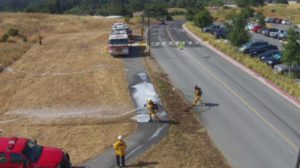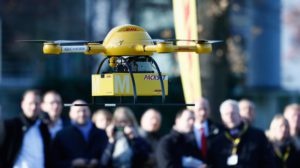Drones have been all over the news lately. And of course, almost all coverage these days whether on drones or our world in general touches on COVID-19. A few of these stories are diving into how new disinfection drones are beginning to spray over public spaces.
As the country moves forward to open more fully, public areas will need to be disinfected constantly. Luckily, there are many reasons why utilizing drones for this task may be the right choice. Can they possibly be more productive? Efficient? Safer? And cost effective?
Technology and The Future
The pandemic is happening in the high-tech era. Why not use it? COVID-19 is an unbelievably contagious illness so it makes sense to take people out of the equation when possible.
Drones have already been used in several positive ways during the pandemic. This includes transportation of goods, surveillance and even education. Now, they are a resource to disinfect large spaces.
During the confusing time navigating the pandemic, it is great to utilize this technology. There is still so much to learn about the novel coronavirus. There is no hiding that it is far more transferable than other illnesses of the past.
Technology will help to limit human to human contact and these disinfection drones are just one example. But, these new devices are on their way to making public spaces safe again.
How do these drones work?
Drones are already used for agricultural spraying. They have become a huge time saver for farmers as they can cover large areas in a fraction of time compared to using other machines or manually. Of course, it was only a matter of time before companies started converting them to spray disinfectant rather than pesticides.
The disinfectant tank is attached to the drone by a hose. The disinfectant is pumped into the spraying drone while a second device flies near to ensure it does not get caught on objects such as railings or seats.
A New York based startup, EagleHawk, has become the most prominent companies to work on this project. Originally, they produced drones that inspected buildings for cracks, leaks, etc. With coronavirus, the company started to deploy disinfection drones. Not only do these drones save time, but they also keep the chemicals away from employees that would otherwise be spraying potentially harmful chemicals.
Not to mention, it is likely that stadiums, arenas, office buildings and more will be required to get cleaned multiple times a day once communities are allowed back into those spaces. According to the WHO, evidence suggests that the virus can survive on hard surfaces for a few hours or even many days. This means that once one infected person touches a surface, it must be cleaned again. Admittedly, there is some skepticism and much debate, even from the WHO (May 16, 2020 CNN’s @MaggieFox) as to whether spraying or fumigation of outdoor spaces, such as streets or marketplaces, is recommended to kill the COVID-19 virus or other pathogens. There is some theory that states, “because disinfectant is inactivated by dirt and debris it is not feasible to manually clean and remove all organic matter from such spaces,” the agency said.
How are disinfection drones helping?
As stated above, the two biggest advantages of disinfection drones will be efficiency and safety.
Efficiency
This is not the first, nor will it be the last, time that technology has improved everyday life. There are some jobs that can be done quicker with machines than normal human-power. Now that indoor and outdoor public spaces will need to be thoroughly cleaned multiple times a day, it has become an impractical job for workers.
According to DJI, disinfection drones are able to clean up to 50 times faster than traditional methods. They also mention that the drones can cover 100,000 square meters with a tank of only 16 liters.
Also, it can become very expensive to clean a stadium using people rather than drones.
Safety
Of course, it is simple to see the benefit of using drones from an efficiency standpoint. However, when dealing with the novel coronavirus, employee safety has to be a major consideration.
Cleaning a stadium to an acceptable level, reaching every inch of each seat, would easily take a crew of 30 to 40 people. This puts so many more workers at risk of catching the illness.
Many other countries across the world have already started to use these drones to curb the spread of coronavirus.
Where are these disinfection drones being used?
Disinfection drones are being designed for both outdoor and indoor environments. This is great news for companies that are looking to transition employees back to office spaces and even malls or smaller retail stores.
Eaglehawk, the company mentioned previously, has been marketing their new product to colleges, schools as well as minor and major league sporting arenas. The company has explained their drones have the ability to spray any large outdoor or indoor space.
Another tech company, Digital Aerolus, has also been working on new drones to battle COVID-19. However, they have focused on creating a drone specifically for indoor spaces. Instead of spraying, they use UVC lights that kill COVID-19 with a 99% disinfection rate. These drones are Aertos 120-UVC. They do not have GPS or external sensors, so they are able to fly into confined spaces. Other drones do not have this capability to disinfect hard to reach places indoors. The Aertos 120-UVC (product SKU: DA-A120UVC) drone provides remote UVC disinfection capabilities for essential businesses in multiple areas:
- Healthcare facilities – patient rooms, hospital rooms, and waiting areas
- Grocery stores – checkout spaces
- Warehouses – product handling areas
- Airplanes and Public Transit – seats and exposed surfaces
- Business common areas – restrooms, workrooms and breakroom surface areas
On the road to normalcy
As COVID-19 hit the world, many companies shifted their business model finding ways to help their communities. Likely, more drone and tech companies will begin to create and sell disinfection drones to aid the world getting back to normal.
News like this brings hope to a usually grim time. Hopefully, public spaces will begin to use this technology to safely bring people together. Although it may be some time away, concerts, sporting events, workspaces and more will reenter everyday life.
This is only just a piece of the puzzle. Yet, in time may become the way of the future.
Sources:
https://abc7ny.com/society/disinfecting-drones-launching-to-fight-covid-19/6176157/
https://enterprise.dji.com/news/detail/fight-covid-19-with-drones


